Christmas Physical Science Photo Album Center Bundle Print and Digital
- Zip
- Google Apps™
- Easel Activity
- Easel Assessment

Products in this Bundle (3)
Also included in
- Save 30% on this set of NINE physical science centers! Students will practice differentiating between kinetic and potential energy, chemical and physical changes, and different types of heat transfer. Standard, fall, and Christmas themed centers are included for each of the 3 topics. Digital and priPrice $25.00Original Price $36.00Save $11.00
Description
Save 25% on this set of Christmas physical science centers! Students will practice differentiating between kinetic and potential energy, chemical and physical changes, and different types of heat transfer, with winter and Christmas holiday themed scenarios. Digital and printable options are included.
The PDF download for each center includes the following, to allow for maximum flexibility:
1. 20 printable cards for use in centers or gallery walks
2. Printable student answer recording sheets
3. Printable answer key
4. Full page version of center cards for printing or projecting
5. Link to Google Slides version of center cards, with drag and drop for answer selection
These are my favorite ways to use these task cards with my students:
-Print the 20 scenario cards and place them in a 4x6 photo album (usually $1-3 from Dollar Tree, Target, or Amazon), for use as a center. You can include a printed recording sheet for each student, or laminate a few for repeated use with dry erase markers.
-Hang the scenario cards around the room with tape. Give each student an answer sheet and clipboard. Set a timer and allow students to read and record answers for each card gallery walk style. When students are finished, project the Google Slides version. Review the cards, pulling popsicle sticks to allow students to share and explain their answer choice.
-Using Google Classroom, assign each student their own copy of the Google Slides version. Allow students to work independently to complete the cards, entering their answers via drag-and-drop as they work.
Aligns with the following standards-based Science objectives:
Differentiate between potential and kinetic energy.
Distinguish between physical and chemical properties.
Use data from an investigation to determine the method by which heat energy is transferred from one object or material to another.
********************************************************************
Follow Nurtured Nature on Instagram and Facebook for updates and inspiration!






